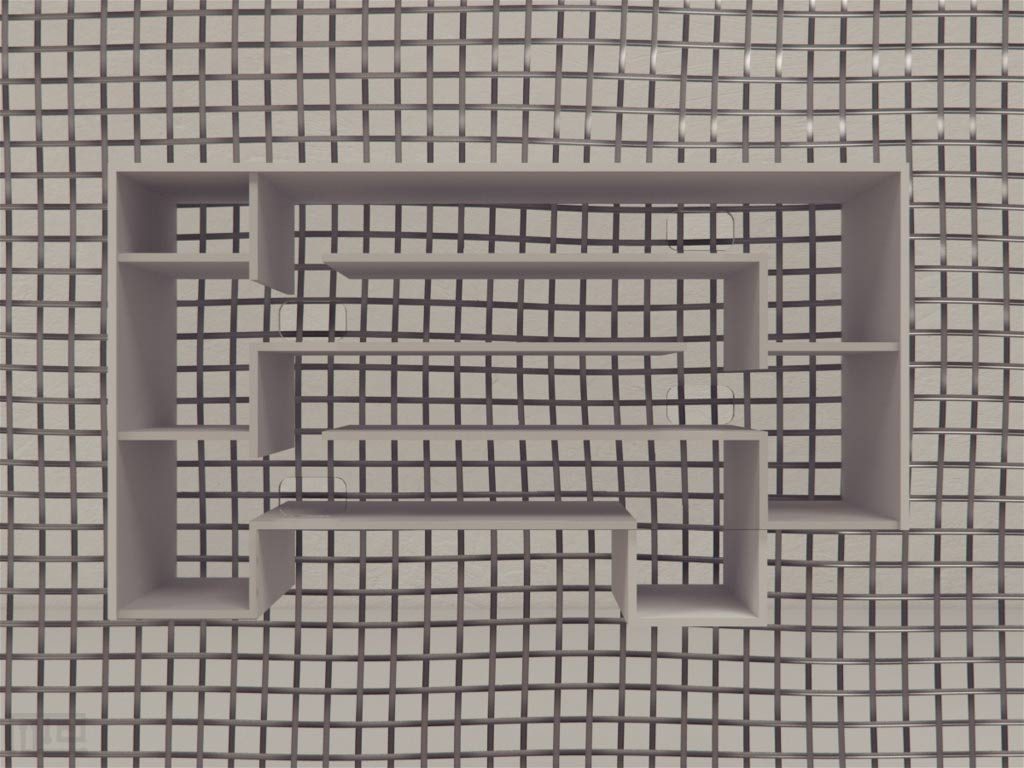Description
The finger maze test is a puzzle conducted by non-human primates to determine memory and cognition. Food reward is usually given after successful completion. The apparatus is an acrylic device that can be set on stainless steel mesh and is comprised of a four-step maze area. The slit in the back allows the infant or primate to move a reward with its finger and can access this reward with the proper route selection.
Price and Size
Primate
$ 1290
Per Month- Four-step maze area
- Length: 18 cm
- Width: 28 cm
- Step height: 3.2 cm
Introduction
The Finger Maze Test is used to study the cognitive function of non-human primates. It comprises a puzzle box that analyzes the learning and memory of monkeys by observing whether they can successfully move a food reward down each level of the apparatus until it reaches a feeding box.
Apes, monkeys, and other non-human primates are valuable models for studying cognitive function in humans. They are extensively used in neuropsychological and neurophysiological research to explain cognitive processes in humans, including multiple brain disorders such as Alzheimer’s and autism since their brains resemble humans more closely than those of rodents (Belmonte et al., 2015). Since learning, memory, and cognitive functions are impaired in patients with brain disorders, researchers continuously investigate these factors to understand these disorders further. The Finger Maze Test can reliably and quickly evaluate the learning and memory of non-human primates. The apparatus comprises a four-step apparatus with a hole present at each end of each level. One hole leads to the next level while the other leads to an error box. At the bottom of all four levels is a feeding box. The apparatus also includes slits on its front wall, which are used by the animal for inserting its finger to move a food reward. During the task, the animal must successfully move the food reward into the correct hole and avoid the error boxes until it reaches the feeding box to retrieve the reward. The higher the level the reward is placed on, the greater challenge the animal faces in navigating the maze and retrieving the reward. Therefore, the task difficulty can be controlled by deciding which step to place the food reward at the beginning of the trial.
The Finger Maze Test can also be used to examine long-term memory in animals by repeating the task a couple of months after completing the learning test. Apart from non-human primates, the apparatus can also be used to study the learning abilities of young kids, old-age people, or those with neurodegenerative disorders.
Apparatus and Equipment
The apparatus consists of four acrylic rectangular-parallel piped boxes placed on top of one another, making it a four-step or four-level apparatus. It measures 173 mm in length and 243 mm in width. Each step’s height is 32 mm. Holes are present at both ends of each step. One hole (22 mm in width) is connected to an error box (55 mm in width) while the other is connected to the lower step or feeding box. If the animal drops the reward into the error box, it cannot retrieve the reward. On the other hand, if it drops the reward into the other hole it drops into the lower step until the reward reaches the feeding box, where it is retrievable.
The apparatus can be set on one of the walls of the animal’s cage.
Data Analysis
The following parameters can be observed using the Finger Maze Test apparatus:
- Number of times the reward is dropped into the error box (error trials)
- Number of times the reward is dropped into the feeding box (correct trials)
- Number of errors made for each step of the apparatus
- Number of times the subject did not reach the reward within the required time limit (no-reaction trials)
- Trial duration
Training Protocol
Habituation
Place a reward in the feeding box without attaching it to the apparatus. Place the feeding box in the subject’s cage and allow it to retrieve the reward. Conduct habituation to the feeding box in the morning.
In the evening of the same day, attach the Finger Maze Test Apparatus to the front wall of the animal’s cage. Place a reward in the feeding box without attaching it to the test apparatus. Allow the subject to retrieve the reward without having to touch or approach the Finger Maze Test Apparatus.
Finger Maze Test
Attach the Finger Maze Test apparatus to the front wall of the animal’s cage. Conduct 15 trials in the morning and 15 in the evening for 5 days a week for each task.
Task 1:
Place the reward on Step 1 of the apparatus. Allow the subject to move the reward into the feeding box or the error box. End the trial once the subject retrieves the reward from the feeding box (correct trial) or drops it into the error box (error trial). Begin the next trial after a 10-second inter-trial interval until the subject achieves the learning criterion of >9 correct trials in 10 consecutive trials. Conduct the next task after the subject achieves the learning criterion.
If the subject does not reach the reward within 120 seconds (no-reaction trial), stop the trial and restart it after a 10-second inter-trial interval. If three consecutive no-reaction trials occur, cancel the session.
Task 2
Place the reward on Step 2 of the apparatus. Allow the subject to move the reward from Step 2 to Step 1 and then to the feeding box. Conduct the rest of the procedure and the learning criterion in the same manner as Task 1.
Task 3
Place the reward on Step 3 of the apparatus and conduct the task in the same way as the previous tasks.
Task 4
Place the reward on Step 4 and conduct the task in the same manner as the previous tasks. After the subject achieves the learning criterion, conduct a random test the following day comprising 32 trials (16 in the morning and 16 in the evening). Assign four trials for each step in which the reward is placed for each session. Randomly assign the order of the trials for each subject.
Literature Review
Investigation of the cognitive abilities of monkeys using the Finger Maze Test Apparatus
Tsuchida et al. (2003) assessed the cognitive abilities of long-tailed macaques (Macaca fascicularis) using the Finger Maze Test Apparatus. The experiment assessed the validity of the apparatus and testing procedure. Seven female monkeys were used in the study.
The experiment consisted of four tasks in which a food reward was placed in each step of the apparatus. In the first task, the reward was placed in Step 1, in task 2 it was placed in Step 2, in task 3 it was placed in Step 3, and lastly, in task 4 it was placed in step 4. During each task, the subject had to move the reward from each step until the reward reached the feeding box where it could retrieve the reward. However, the apparatus challenged the subjects such that each step contained a hole on each end, one leading to the next step and finally the feeding box, while the other one led to an error box where the reward was irretrievable and the trial was ended. After the subjects completed all four tasks, which were conducted 15 times in the morning and 15 times in the evening for 5 days, a random test was conducted the following day. During the random test, the reward was randomly assigned to one of the four steps across four trials in a session.
The results indicated a significant effect of step on task performance in which more errors occurred in step 2 than step 1 in Task 2 and 3, and step 3 than step 1 in Task 4. Overall results suggested that the Finger Maze Test Apparatus can readily and objectively analyze the cognitive abilities of monkeys.
Investigation of the effect of thiamazole exposure on the learning and memory abilities of monkeys
Inoue, Arima, Kato, and Ebihara (2014) investigated how thiamazole exposure during the fetal period of monkeys affected their learning and memory abilities. The experiment was conducted on infant cynomolgus monkeys using the Finger Maze Test. The animals were divided into control, and 2.0 mg/kg and 3.5 mg/kg Thiamazole exposure groups. The experiment was conducted similarly to Tsuchida et al. (2003); however, the number of trials per day was reduced and the learning criteria were simplified. Moreover, a long-term memory test was conducted two months after completing the random learning test.
The results from training revealed no significant difference in the number of sessions for achieving the learning criterion for each step and the duration of training between all three groups. Similar results were observed in the learning test, indicating that thiamazole exposure during the fetal period did not significantly affect the subjects’ accuracy in making the correct decision for each step and in learning the layout of the maze. However, results from the long-term memory test revealed that the thiamazole group’s success rate remained lower than their results from the learning test conducted two months before compared to the control groups. Moreover, they took a greater time to complete the test than the control group. Therefore, the results suggested that thiamazole during the fetal period causes memory deterioration, which was reliably detected by the Finger Maze Test Apparatus.
Investigation of planning abilities in young apes and human children
Völter and Call (2014) utilized a modified version of the Finger Maze Test apparatus to assess the planning abilities of younger apes and human children. Twelve young apes of four great ape species participated in the study, comprising seven chimpanzees (Pan troglodytes), one gorilla (Gorilla gorilla), two bonobos (Pan paniscus), and two orangutans (Pongo abelii). Additionally, 4- and 5-year-old human pre-schoolers were also tested.
The apparatus had three horizontal levels, which had ten gaps distributed among them. The gaps allowed the reward to be moved from one level to the other until it reached the lowest level where it could be retrieved. The gaps were distributed in a way that whenever the subject successfully moved a reward down a gap onto the next level another choice between two gaps was given. The apparatus also included a vertical partition between the second and third gaps on the second and third levels. Each level contained narrow slits that allowed the subject to move the reward. Traps were placed in some of the gaps, which blocked the reward from reaching the lower level. Therefore, the task assessed the planning abilities of the subjects since they had to plan their way around several traps up to two traps ahead to get the reward.
The results indicated that younger apes and 5-year-old children planned their movements up to two steps in advance, whereas 4-year-olds could only plan one step ahead. Moreover, apes and children performed similarly but with different underlying restrictions. The ape species were constrained by a lack of motor control whereas young children showed difficulty dividing their attention between several different subgoals.
Investigation of cognitive function of adult rhesus monkeys
Kim et al. (2020) utilized the Finger Maze Test to assess the cognitive function of adult rhesus monkeys. The experiment was conducted in the same manner as Tsuchida et al. (2003) in which the monkeys had to move the reward across different levels of the apparatus to retrieve it. In addition, a memory test was conducted two months later in the same manner as the learning test. Each subject’s training period varied. The results indicated that despite variations in training duration between each monkey, eleven out of the twelve monkeys tested finished the training and performed well in both the learning test and the memory test that was done two months later.
Strengths and Limitations
Strengths
The Finger Maze Test apparatus can quickly and reliably evaluate the cognitive function of monkeys, apes, and even humans. The apparatus is essentially a puzzle box with four horizontal levels, which vary in difficulty. The highest level is the most difficult since the subject has to successfully move the reward through multiple levels to retrieve it. Therefore, the task difficulty can be easily controlled at the beginning of the trial by choosing which step to place the reward on. The apparatus can be attached to the wall of the home cage of the animal; therefore, stress from being in a novel environment is eliminated.
Limitations
The animal’s motivation to engage in the task and retrieve the reward is highly important.
Summary
The Finger Maze Test is used to study the cognitive function of non-human primates.
- The apparatus comprises a four-step apparatus with a hole present at each end of each level. One hole leads to the next level while the other leads to an error box. At the bottom of all four levels is a feeding box.
- The apparatus analyzed the learning and memory of monkeys by observing whether they can successfully move a food reward down each level of the apparatus and avoid the error boxes until it reaches the feeding box.
- Task difficulty can be controlled by deciding which step to place the food reward at the beginning of the trial.
- The apparatus can be used to assess the long-term memory of monkeys by conducting the same learning test after an extended period such as a couple of months.
- The apparatus can be used to assess the effects of drugs on memory.
- The apparatus can also be used to study the learning abilities of young kids, old-age people, or those with neurodegenerative disorders.
References
Tsuchida, J., Kawasaki, K., Sankai, Kubo N., Terao, K., Koyama, T., Makino, J., & Yoshikawa, Y., (2003). New Type of Puzzle-Task Finger Maze Learning in Macaca fascicularis . International Journal of Primatology, 24(2), 261–270. https://doi.org/10.1023/A:1023040931101
Izpisua Belmonte, J. C., Callaway, E. M., Caddick, S. J., Churchland, P., Feng, G., Homanics, G. E., Lee, K. F., Leopold, D. A., Miller, C. T., Mitchell, J. F., Mitalipov, S., Moutri, A. R., Movshon, J. A., Okano, H., Reynolds, J. H., Ringach, D., Sejnowski, T. J., Silva, A. C., Strick, P. L., Wu, J., … Zhang, F. (2015). Brains, genes, and primates. Neuron, 86(3), 617–631. https://doi.org/10.1016/j.neuron.2015.03.021
Inoue, A., Arima, A., Kato, H., & Ebihara, S. (2014). Utility of finger maze test for learning and memory abilities in infants of cynomolgus monkeys exposed to thiamazole. Congenital anomalies, 54(4), 220–224. https://doi.org/10.1111/cga.12068
Völter, C. J., & Call, J. (2014). Younger apes and human children plan their moves in a maze task. Cognition, 130(2), 186–203. https://doi.org/10.1016/j.cognition.2013.10.007
Kim, K., Jeon, H. A., Seo, J., Park, J., Won, J., Yeo, H. G., … & Lee, Y. (2020). Evaluation of cognitive function in adult rhesus monkeys using the finger maze test. Applied Animal Behaviour Science, 224, 104945. https://doi.org/10.1016/j.applanim.2020.104945



